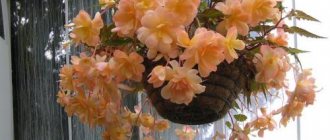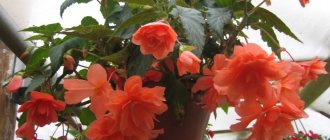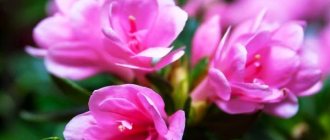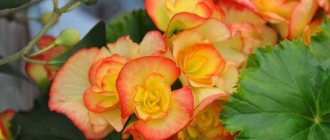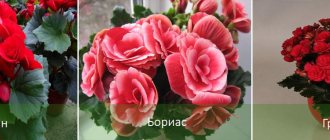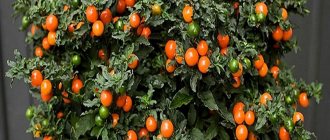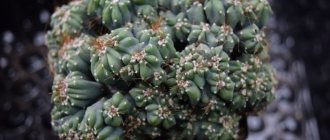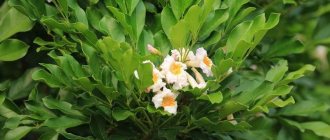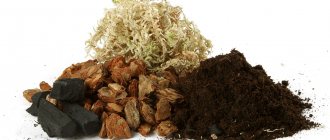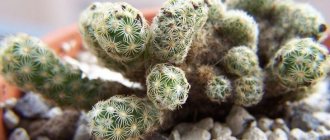Among the hybrid species of begonias, elatior occupies a special place. Bright, lush flowers of regular shape are in many ways reminiscent of chic small roses. They appear in inflorescences, several at a time. Thanks to this, the petals almost completely cover the greenery and create the effect of a beautiful flower carpet.
That is why begonia elatior is a real favorite among flower growers: it is planted both in apartments and in city flower beds.
Botanical description of the plant
This type of begonia belongs to the perennial shrubby plants. It usually grows in height up to 30-45 cm. The leaves of elatior have quite original carved shapes, in some cases they even resemble hearts with unequal halves. The stems are quite fleshy, the foliage is a rich green shade, against which the flowers contrast very harmoniously:
- red;
- white;
- cream;
- yellow;
- orange;
- pink;
- coral
Depending on the specific size of the stem, three groups of begonia elatior varieties are distinguished:
- short (about 20-25 cm);
- medium height (25-35 cm);
- tall (35-45 cm).
Features of the flower
During selection, Elation begonia has become widespread - it is grown more often than other begonias and bought as a gift.
Fame, however, has led to a number of misconceptions even among experienced gardeners - for example, this species is often considered a tuberous one, although in fact the flower is a hybrid of Socotrans and tuberous begonias. However, this is not surprising - the result of the crossing was amazing.
The flowering bush grows on average up to 40 centimeters, is distinguished by succulent fleshy stems and glossy dense leaves of a carved shape with jagged edges of a characteristic color (the top is juicy green, the underside is pale light green). During flowering, the plant is covered with bright inflorescences of rich, rich shades on thin peduncles growing from the axils of the leaves.
Varieties of begonia elatior
Here are the most interesting varieties of begonia elatior, which are often used as indoor plants:
- Baladin grows up to 30 cm, but produces flower stalks of different heights. This creates an interesting multi-tiered effect - some flowers grow on top of others. From afar, such a bush resembles a bouquet of roses. And rich bright colors always attract attention and enliven the space.
Representatives of the Baladin variety have every chance of becoming an original gift for a lovely lady - such a plant really resembles a bouquet. But this bouquet will not dry out even for several years, and it will produce flowers more than once a year.
- In distant and romantic England, another interesting variety of begonia elatior called Borias . It produces delicate flowers in pink and coral colors. And even in the photo their similarity with classic roses is striking. In this sense, elatior is truly a royal flower.
And if you put several of these pots in a row, eternal spring will come on the windowsill.
And single bushes are quite self-sufficient. And the whole point is that they produce very beautiful, rather large flowers. Needless to say, such a gift will be no less pleasant than the usual roses or tulips!
- And there is another literally bright representative of the glorious Elatior family. the Grace variety , which was developed in Southeast Asia. It grows no more than 35 cm. But it produces a lot of red flowers, which bloom several times a year. And most importantly, they do not fade within 1-2, sometimes 3 months. Needless to say, flowers are again very similar to roses, only they live much longer.
There are also varieties with beautiful orange flowers - they can create a spring atmosphere in the apartment even on long winter evenings.
Planting in open ground
Planting begonias in open ground is not difficult. The main thing is to know the sequence of work, prepare the nutrient substrate and carry out the transplant slowly and carefully.
Preparing tubers for planting
Not all gardeners know how to plant begonia. First you need to prepare its tubers for transplanting. To do this, they are cleared of soil and all bad shoots are removed. If the plant’s bulb is large (more than 5 cm), it should be divided into two parts. When dividing the onion, all cut areas are treated with activated carbon, which must first be crushed. After this, the tubers are placed in a weak fungicide solution for half an hour.
Important: when replanting a plant, the tubers must be handled very carefully. They should not be pressed, as they will probably not germinate in the future.
Where to plant a flower on the site
When choosing a place to plant begonias, preference is given to well-lit or slightly darkened areas. When choosing a sunny meadow, it is worth considering that the leaves of the plant should not be constantly exposed to the scorching rays of the sun, otherwise burns will appear on them. A place with diffused sunlight would be a good choice. Since when planted in the shade, the shoots will not have enough ultraviolet radiation, and they will begin to stretch out and become thinner. The only thing is that the plant should not be planted in lowlands or where groundwater is close to it, as its root system will simply begin to rot.
Important : it is recommended to transplant begonia into open ground in dry and sunny weather, preferably in the morning.
What soil does the plant prefer?
Begonia in the garden will grow well in loose and nutritious soil. It is better to prepare a place for planting in the fall. To do this, the selected place is dug up, all weeds and other debris are removed, peat, sand and rotted compost are added to the ground. Then the earth will become nutritious and breathable.
How to care for begonia elatior: 10 flowering secrets
Caring for any plant is based on one important rule: for the flower you need to create conditions that are as close as possible to its natural habitat. In the case of begonia elatior, it is important to remember that the birthplace of this flower is the distant tropics.
This means that the plant is accustomed to eternal summer, fairly abundant watering and fertile soils. But everything is good in moderation. Therefore, in order to achieve lush and stable flowering, you should pay attention to the following tips:
- It is very important to ensure optimal watering . It should be quite abundant - as soon as the upper half of the soil has dried, a new portion of settled water should be added. However, overfilling is even worse - the water in the pan should not stagnate too much.
- Moist air is another rule for caring for begonia elatior at home. Spraying the leaves and especially the flowers is unacceptable, but placing a bowl of water next to the plant or placing a damp towel is a mandatory measure in the summer.
- Lighting should be diffused , but at the same time bright. This is very easy to achieve - you can simply place the pot behind the tulle, and in the summer, cover the lower part of the window with a sheet of white paper. Elatior, unlike many other types of begonias, does not need additional lighting even in cloudy weather or in the autumn-winter period.
- The plant is located away from drafts and heating radiators - cold and dry, hot air are equally harmful to begonias.
- The optimal temperature is slightly lower than normal room temperature: +18°C...+20°C . The air should not cool below +16°C - the plant will shed its buds and may even get sick.
- During the flowering period (from the beginning of the formation of buds until the flowers wither), complex mineral fertilizers are used . They are taken in small quantities (compared to the instructions in the instructions, 1.5-2 times less), since begonia does not like soil salinity. It is better not to feed with organic matter - due to nitrogenous substances, the plant loses its vigor, and the flowers lose their visual appeal.
- For planting, you can take any pot, but the soil is selected from peat, leaf and greenhouse humus (in equal quantities). You can add a little river sand and perlite. The soil must be loose and airy.
- Almost every year, a young plant is transplanted into a new pot , which is 4-5 cm in diameter larger than the previous pot. And it is not advisable to disturb a flower that is already 4 years old (or more).
- Periodically, faded leaves should be removed , as well as flower stalks after the petals have withered. This is done with a sharp knife, and the cut areas are covered with wood ash.
- And one more rule for caring for begonia elatior at home is regular inspection for the presence of diseases and the appearance of pests, as shown in the photo (using the example of gray rot).
Rules of care
In order for the plant to delight with the freshness of its leaves and long-lasting flowering, you should be attentive to its needs, ensuring:
- temperature regime - without dropping the heat below 18-20 degrees - this is the extreme threshold for the survival of a flower; at other temperatures, leaves and peduncles will be irreversibly damaged;
- correct watering - often the flower is watered only during the period of active growth, and already during flowering the amount of water is reduced by three times (the plant itself will report a lack of moisture - lowering the flower stalks);
- prohibition of spraying - no matter how much you would like to restore the brightness of the flower during the dormant period, droplets of water on the leaves will lead to their damage;
- pruning - cuttings of perennial bushes should be cut every spring, leaving no more than 8-10 centimeters;
- removing faded buds that drain the plant’s strength, preventing the appearance of new flowers;
- alternate feeding with stimulants and immunomodulators (for example, Epin, Zircon);
- use of fertilizers - any mineral fertilizers are suitable for begonia, while it is better not to use organic fertilizers due to the abundance of nitrogen, which worsens the structure of the cuttings and stems (they become watery, weak, brittle, sluggish, and flowering will be weak).
Reproduction at home in different ways
This flower is propagated by seeds, cuttings, and also by simply dividing the mother bush into several daughter bushes. The simplest methods of propagating begonia elatior at home are described in detail and clearly in the video.
But growing begonia elatior from seeds is somewhat more difficult, and the rules for caring for seedlings are not simple. However, this method of reproduction is also available.
It is better to purchase seed material in a specialized store. They sell seeds in 2 forms:
- Regular (unprocessed).
- Granulated (in the form of dragees) - they are easier to work with.
Regardless of the type of material, the planting technology is the same (planted at the very beginning of spring):
- The seeds are pre-treated with a 1% solution of potassium permanganate for 30-45 minutes.
- They are then washed and planted in a pre-moistened peat tablet.
- Each tablet is placed on a tray, which is covered with polyethylene or glass.
- Then water is constantly added to the tray so that the surface of the tablet is always moderately moist. The room temperature is at least 20-22oC.
- Normally, the first shoots appear after 2-3 weeks. After the formation of the third leaf, a pick is made.
- They dive again 8 weeks after emergence. At the same time, the sprouts are planted in pots.
Possible problems
- The cut of the cutting began to rot in the water. The plant may have become infected with a fungal infection. It is necessary to remove the cutting from the water, cut off the rotten part, place it in a container with fresh water, into which ½ tablet of activated carbon is added.
- Elatior begonia seeds do not hatch for a long time . Perhaps the reason for this is dry soil, or low room temperature. Measures should be taken: moisten the soil and increase the room temperature to +22-24°C.
- The seedlings stretch out, becoming long and thin. The plants clearly do not have enough sunlight. If possible, it is worth moving containers with seedlings closer to the light source.
- Slow growth. Perhaps the young plant does not have enough nutrients in the soil, so it should be fed with fertilizers.
Diseases and pests of begonia elatior
Disturbances in the development of begonia elatior are associated mainly with improper maintenance conditions and infectious pathogens of flower diseases.
The most common ones include:
| external sign | cause | solution |
| the leaves dry out at the edges and begin to curl | dry and hot air | move to a cooler place, periodically humidify the air |
| leaves fall off or turn yellow and droop | too cold | move to a warmer place |
| the foliage has drooped | polluted air or lack of moisture | take the pot to another room, water it thoroughly (if the soil is dry) |
| leaves grow small, flowers do not form or bloom rarely | lack of fertilizer | fertilize the soil using organic or mineral fertilizers |
| leaves fade, cobwebs are found | spider mite activity | use an insecticide or onion infusion (more details below) |
| powdery coating with greenish and brown tints | activity of gray mold fungus | spray with fungicide (benomyl) according to instructions and remove the pot to a dry, cooler place |
| white spots of powdery consistency | activity of powdery mildew fungus | |
| the roots turn black and rot | black root rot fungus activity | stop watering, spray with fungicide, remove to a drier place |
| rot on the surface of leaves and flowers | waterlogging | reduce watering, do not allow moisture to get on the begonia itself when spraying |
| leaves are deformed, yellow spots appear on the surface | activity of cucumber mosaic virus | destroy the flower, disinfect the pot, replace the soil |
| the leaves have lost color, sagging is visible on the roots | nematode activity |
As for begonia pests, the most dangerous are:
- The spider mite is a round-shaped insect, bright red in color, less than 1 mm long. They look like numerous bright dots on the surface of leaves and stems. Leaves cobwebs throughout the plant.
- Aphids have different colors (green, gray, brown), the body shape is round, 2-3 mm long. They look like numerous gray dots.
They need to be dealt with immediately after detection. For this purpose, special insecticides are used, which can be purchased at a specialty store:
- thiophos;
- karbofos;
- actellik;
- neoron;
- fitoverm;
- fufanon.
They act exactly according to the instructions. You can also use a home remedy based on regular onions (with brown peel):
- The onion is chopped very finely or passed through a meat grinder.
- Take a full teaspoon (half a tablespoon) and leave for 1 week in a liter of water.
- Strain and spray the foliage and stems until the insects are completely destroyed.
PREVENTION ADVICE
The foliage and especially the stems of the plant hidden under the bush must be carefully inspected for the presence of pests and other damage. The sooner you start fighting them, the higher the chances of success.
Types and varieties
The Elatior class of begonias was created more than a century ago, in 1883 in London. It is not surprising that today a lot of plant varieties have appeared. Breeders managed to achieve not only a variety of shapes and colors of the crop, but also excellent technical characteristics. The plant is resistant to fungal diseases and rarely causes trouble even for amateurs.
We will describe only some varieties; it is impossible to cover all the diversity. In addition, the availability of varieties for sale from region to region may vary greatly and for some the varieties described below will be rare, for others - on the contrary.
- Annebell - semi-double yellow flowers. Open ground plant.
- Azotus - double pink flowers. Indoor plant.
- Baladin
is a famous Baladin variety. Compact (up to 25 cm), flowers are semi-double, bright red. - Balamon
- juicy terry orange-red. - Barkos - double, bright, red flowers.
- Batik
- semi-double and single juicy orange flowers. - Bellona - flowers are red, double, large.
- Berseba
and
Berseba Red
- densely double pink and red flowers, so abundant that the foliage is not visible. - Berlin - light pink, lush, double flowers. Used as a potted plant.
- Binos
is a variety series with textured, double, dense flowers collected in powerful brushes. Colors: Binos - coral, Pink - dark pink, Binos Soft Pink - delicate pink-peach with a yellowish center. - F1 Charisma is a variety series of low hybrids up to 25 cm with double and very large flowers (5 cm), blooms for a very long time and profusely. Shades: Lachsorange - dark salmon, Rosa - dark pink flowers, Scharlach - orange-red flowers, Tiefrose - dark pink.
- Blitz
- bright yellow semi-double flowers. - Bonbon White
- simple and semi-double flowers, white with greenish shades. - Borias.
Begonia Elatior Borias is a compact plant with simple and double flowers of pink color with a white edge. Flowering is very long, and the plant itself pleases with the freshness of its colors and glossy foliage. - Britt Dark
- simple flowers of hot orange color. - Camilla
- very delicate semi-double white-pink flowers, with a red edge around the edge and yellow-green central petals. - Carneval
- contrasting cheerful colors, the central petals are yellow with an orange tint, the outer petals are orange-red. - Catrin
- small, two-tone orange-reddish flowers, a beautiful contrast with the dark green foliage. The plant is spreading and lush. - Ceveca
has an unusual form of semi-double coral pink flowers. The petals are very elongated, palmate, brightly expressed, the flowers are very large. - Cindy Franje
- apple-pink flowers with a greenish center and a thin red edge, an unusual serrated edge of the petals. - Clara
- single and semi-double white flowers. The buds are greenish, which adds charm. - Cottage Collection
is a series of ampelous forms, with especially long peduncles that end in clusters of medium-sized semi-double flowers.
Shades: Bright Red -
juicy red,
Double Pink
- bright Barbie pink,
Salmon
- salmon,
Vintage Pink
- delicate pink with a slightly beige undertone. - Cottage Vintage Pink
is a more compact form than the plants from the Cottage Collection. The flowers are simple, pinkish-beige, a sophisticated shade reminiscent of the tones of an old postcard. - Cleo - salmon flowers, semi-double, medium-sized, bloom abundantly.
- Dragone Champagne
- dense, apple blossoms. - Dragone
- abundant, densely double, bright pink flowers with a cap. - Eva
- very bright and abundant yellow flowers. - Goldfinger - light creamy yellow flowers, double. Potted plant.
- Glory Pink
- large semi-double pink flowers, very dark foliage.
Glory White
- has flowers of a beautiful shape, as if carved from porcelain, white in color with a slightly yellowish center. - Janny Franje
and
Kristy Franje
are two varieties with multi-tonal flowers of complex colors, with slightly serrated edges of the petals.
Janny
- pale orange and apple green tones.
Kristy
- the most delicate pink and greenish shades. Very refined varieties. - Kyoto - t branches are white, large, densely double.
- Lax
- very large, semi-double, orange-pink flowers on dark green foliage. - Louis - light cream and pink flowers.
- Nadine
- bright yellow semi-double flowers. - Nelly -
similar to Kristy Franje, only without such pronounced apple-green shadows. - Netja Dark
- abundant, hot pink flowers with a cap. - Peggy
is an unusual luminous color. Luscious pink flowers with a white glow from the center. - Piccora - flowers are large, double, bright pink. Feels great in open ground.
- Red Baron Dark
- very dense, double, bright red flowers. - Red Improved
- double, dark red flowers. - Renaissance . The plants are tall, the flowers are red, densely double, corrugated, decorative rugged leaves. A houseplant, it does not grow well in open ground.
- Sandrine
- coral pink hot flowers, apple green in buds. - The Solenia series
has very large, double flowers, reminiscent of tuberous begonias.
Colors: Dark Pink
- dark pink,
Light Pink
- light pink,
Light Yellow -
lemon yellow,
Orange
- orange,
Red Orange
- red-orange,
Soft Pink
- silky light pink flowers. - Sweet Dreams
- candy pink flowers with unusual elongated petals. - Schwabenland - bright red branches, non-double, small, very abundant flowering.
- Veronica
- abundant, clear, as if chiseled, double red flowers. - Yellow Stone
- densely double, sunny yellow flowers.
Variety Dragone Rosewood
Variety Barbara
Reviews from gardeners about begonia elatior
In general, flower growers are very pleased with representatives of the Begonia elatior species. As a rule, such flowers are purchased in disposable pots, then transplanted into durable containers and sprayed with fungicide to avoid the development of fungi and bacteria.
Begonia owners note that the plant pleases with its beautiful, bright flowers almost all year round.
Of course, reviewers also talk about certain shortcomings. Basically, gardeners describe how the plant begins to quickly turn yellow and wilt due to lack of watering or spraying the leaves with a spray bottle. It is often pointed out that Elatior is quite difficult to care for.
However, it is worth keeping in mind that beauty almost always requires sacrifice. And of course, in the case of such an interesting indoor plant, the word “victim” is inappropriate.
Moderate watering, sufficient heating and lighting are the basic rules for success. You should frequently inspect your pet for pests or signs of disease. Otherwise, caring for begonia elatior at home is as simple as caring for less demanding plants.
Feeding, processing and watering
I feed begonias once a month with a solution of Crystalon green, reducing the concentration recommended by the manufacturer by three times. Once a month, it is advisable to water the soil in the pot with a fungicide solution. For this purpose I use the bactericide Gamair or Fitosporin.
I can’t give any advice on protection against pests: although my begonia was outdoors in the summer, no parasites settled on it.
Begonia is often affected by rot, the development of which is primarily caused by improper watering. It is necessary to moisten the soil in pots often, but moderately, so that stagnation of water does not form in the roots of the begonia. Try to balance the moisture so that the soil does not dry out or become too wet.
